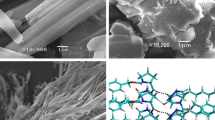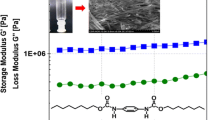Abstract
The gelating properties and thermotropic behaviors of stoichiometric mixtures of aromatic amides 1, 2, and the aromatic Schiff base 3 with tartaric acid (TA) were investigated. Among the three gelators, 2-TA exhibited superior gelating ability. Mixture 2-TA exhibits a smectic B phase and an unidentified smectic mesophase during both heating and cooling runs. The results of Fourier transform infrared spectroscopy and X-ray diffraction revealed the existence of hydrogen bonding and π-π interactions in 2-TA systems, which are likely to be the dominant driving forces for the supramolecular self-assembly. Additionally, it was established that all of the studied gel self-assemblies and mesophases possess a lamellar structure. The anion response ability of the tetrahydrofuran gel of 2-TA was evaluated and it was found that it was responsive to the stimuli of F−,Cl−,Br−,I−, AcO−.

Similar content being viewed by others
References
Bhattacharjee S, Bhattacharya S. Orotic acid as a useful supramo-lecular synthon for the fabrication of an OPV based hydrogel: stoichiometry dependent injectable behavior. Chemical Communications, 2015, 51(31): 6765–6768
Raeburn J, Adams D J. Multicomponent low molecular weight gelators. Chemical Communications, 2015, 51(25): 5170–5180
Buerkle L E, Rowan S J. Supramolecular gels formed from multi-component low molecular weight species. Chemical Society Reviews, 2012, 41(18): 6089–6102
Liu M H, Quyang G H, Niu D, Sang Y. Supramolecular gelaton: Towards the design of molecular gels. Organic Chemistry Frontiers: An International Journal of Organic Chemistry / Royal Society of Chemistry, 2018, 5(19): 2885–2900
Tu T, Zhu H B, Fang W W, Zhang Y, Wu J J, Liu C. Advance between supramolecular gels and catalysis. Chemistry, an Asian Journal, 2018, 13(7): 712–729
Verma I, Rajeev N, Mohiuddin G, Pal S K. Ordering transitions in liquid crystals triggered by bioactive cyclic amphiphiles: Potential application in label-free detection of amyloidogenic peptides. Journal of Physical Chemistry C, 2019, 123(11): 6526–6536
Kato T, Mizoshita N, Kishimoto K. Functional liquid-crystalline assemblies: Self-organized soft materials. Angewandte Chemie International Edition, 2006, 45(1): 38–68
Wang L Y, Liu S X, Li H M, Huang Y D. Preparation and properties of the two-component hydrogels based on pyrazine dicarboxylic acid and melamine. Chemical Journal of Chinese Universities, 2017, 38(5): 806–813
Mahapatra R D, Dey J. Instant gels from mixtures of amines and anhydrides at room temperature. Colloids and Surfaces. B, Biointerfaces, 2016, 147: 422–433
Hamaguchi K, Kuo D, Liu M M, Sakamoto T, Yoshio M, Katayama H, Kato T. Nanostructured virus filtration membranes based on two component columnar liquid crystals. ACS Macro Letters, 2019, 8 (1): 24–30
Mahalingam T, Venkatachalam T, Jayaprakasam R, Vijayakumar V N. Structural and thermo-optic studies on linear double hydrogen bonded ferroelectric liquid crystal homologous series. Molecular Crystals and Liquid Crystals (Philadelphia, Pa.), 2016, 641(1): 10–24
Yang J H, Christianson L A, Gellman S H. Comparison of an HXH three-center hydrogen bond with alternative two-center hydrogen bonds in a model system. Organic Letters, 1999, 1(1): 11–13
Deebika B, Balamurugan S, Kannan P. Liquid crystalline H-bonded polymers influenced by chiral and achiral spacers. Journal of Polymer Research, 2012, 19(7): 9920–684
Yamaguchi D, Eimura H, Yoshio M, Kato T. Redox-active supramolecular fibers of a nitronyl nitroxide-based gelator. Chemistry Letters, 2016, 45(8): 863–865
Takemoto Y, Uchida Y, Shimono S, Yamauchi J, Tamura R. Preparation and magnetic properties of nitroxide radical liquid crystalline physical gels. Molecular Crystals and Liquid Crystals (Philadelphia, Pa.), 2017, 647(1): 279–289
Huang Y, Zhang X, Cui W, Wang X, Li B, Zhang Y, Yang J. Novel liquid crystalline organogelators based on terephthalic acid and terephthalaldehyde derivatives: Properties and promotion through the formation of halogen bonding. New Journal of Chemistry, 2020, 44(2): 614–625
Bao C Y, Lu R, Jin M, Xue P C, Tan C H, Liu G F, Zhao Y, Zhao Y Y. L-Tartaric acid assisted binary organogel system: Strongly enhanced fluorescence induced by supramolecular assembly. Organic & Biomolecular Chemistry, 2005, 3(14): 2508–2512
Huang Y D, Yuan Y Q, Tu W, Zhang Y, Zhang M J, Qu H M. Preparation of efficient organogelators based on pyrazine-2,5-dicarboxylic acid showing room temperature mesophase. Tetrahedron, 2015, 71(21): 3221–3230
Shishido Y, Anetai H, Takedam T, Hoshino N, Noro S, Nakamura T, Akutagawa T. Molecular assembly and ferroelectric response of benzenecarboxamides bearing multiple -CONHC14H29 chains. Journal of Physical Chemistry C, 2014, 118(36): 21204–21214
Feng G L, Chen H H, Cai J H, Wen J W, Liu X B. L-Phenylalanine based low-molecular-weight efficient organogelators and their selective gelation of oil from oil/water mixtures. Soft Materials, 2014, 12(4): 403–410
Yamanaka M, Aoyama R. Construction of two- or three-component low molecular weight gel systems. Bulletin of the Chemical Society of Japan, 2010, 83(7): 1127–1131
Xue P C, Zhang Y, Jia J H, Xu D F, Zhang X F, Liu X L, Zhou H P, Zhang P, Lu R, Takafuji M, Ihara H. Solvent-dependent photophysical and anion responsive properties of one glutamide gelator. Soft Matter, 2011, 7(18): 8296–8304
Cao X H, Zhao N, Lv H T, Gao A P, Shi A P, Wu Y Q. 4-Nitrobenzene thiourea self-assembly system and its transformation upon addition of Hg2+ ion: Applications as sensor to fluoride ion. Sensors and Actuators. B, Chemical, 2018, 266: 637–644
Huang Y D, Liu S X, Xie Z F, Sun Z P, Chai W, Jiang W. Novel 1,2,3-triazole-based compounds: Iodo effect on their gelation behavior and cation response. Frontiers of Chemical Science and Engineering, 2018, 12(2): 252–261
Gao A P, Li Y R, Lv H T, Liu D, Zhao N, Ding Q Q, Gao X H. Melamine tunable effect in a lenalidomide-based supramolecular self-assembly system via hydrogen bonding. New Journal of Chemistry, 2017, 41(16): 7924–7931
Kaczmarczyk B. FTi.r. study of hydrogen bonds in aliphatic polyesteramides. Polymer, 1998, 39(23): 5853–5860
Hermansson K. Blue-shifting hydrogen bonds. Journal of Physical Chemistry A, 2002, 106(18): 4695–4702
Ghosh S, Goswami K, Ghosh K. Pyrrole-based tetra-amide for hydrogen pyrophosphate (HP2O73−) and F− ions in sol-gel medium. Supramolecular Chemistry, 2017, 29(12): 946–952
Lin Q, Zhu X, Fu Y P, Zhang Y M, Fang R, Yang L Z, Wei T B. Rationally designed anion-responsive-organogels: Sensing F via reversible color changes in gel-gel states with specific selectivity. Soft Matter, 2014, 10(31): 5715–5723
Song H H, Yoo J H, Doe J K, Lee K S, Choi Y K, Keum S R. Liquid crystal structures of spirobenzopyram derivatives. Molecular Crystals and Liquid Crystals (Philadelphia, Pa.), 2000, 349(1): 267–270
Marzec M, Popczyk J, Fąfara A, Wróbel S, Dąbrowski R. Antiferroelectric liquid crystals studied by differential scanning calorimetry and electrooptic methods. Ferroelectrics, 2002, 281(1): 123–134
Acknowledgements
This work was supported by the Natural Science Foundation of Tianjin (No. 15JCYBJC20100).
Author information
Authors and Affiliations
Corresponding author
Rights and permissions
About this article
Cite this article
Wang, X., Cui, W., Li, B. et al. Supramolecular self-assembly of two-component systems comprising aromatic amides/Schiff base and tartaric acid. Front. Chem. Sci. Eng. 14, 1112–1121 (2020). https://doi.org/10.1007/s11705-019-1865-5
Received:
Accepted:
Published:
Issue Date:
DOI: https://doi.org/10.1007/s11705-019-1865-5




